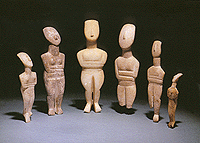The production of figurines in the Aegean islands during the Bronze Age includes anthropomorphic and zoomorphic figurines made of clay, bone, shells and stone, mainly marble. Their discovery in houses, graves and sanctuaries shows that these were not made only as works of art but as objects of a
wide social-ideological content and symbolic-religious dimensions.
The marble figurines, mainly female figures, of the Early Cycladic period (3200-2000 BC), which are the diagnostic element of the so-called Cycladic culture are of great importance for the
figurine manufacture of the Early Bronze Age. Some of these represent persons of the Cycladic society
such as musicians, warriors and pregnant women. The size of other figurines (about 1,5 metres) indicate clearly that that the plastic art of large-sized figurines was born in the Aegean, in the small Cyclades. In the other islands the manufacture of figurines is extremely restricted, in contradiction to the rich and inspired figurines of the Neolithic period (6800-3200 BC). Toward the Late Bronze Age large clay, handmade or
wheelmade figurines from the sanctuaries of the Late Cycladic towns of Agia Irini and Phylakopi
as well as smaller Fi and Psi type figurines which observe strictly the figurine manufacture of
Mycenaean Greece are distinguished.
The zoomorphic Early Cycladic figurines are made mainly of marble or clay and
represent animals and birds. At the same time, clay zoomorphic vases of a ritual character (e.g. hedgehog) occur frequently. During the Late Cycladic period figurines representing goat, sheep, cattle, etc. are made according to the Mycenaean models and bear painted decoration.
|
 |